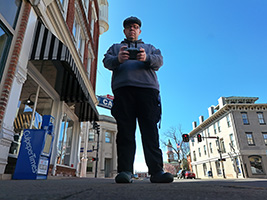An Urban Comparison
Introduction – Washington, DC – Richmond – Norfolk – Roanoke
Richmond, Virginia
Richmond has a considerably different character than the DC area. The “European” feel of DC is not here, as Richmond is very much an all-American city in its styling. Much of Richmond’s business district was built from 1975 to 1990 during a building boom. Richmond is also home to the tallest building in Virginia at the time – the James Monroe Building. Unfortunately, highway construction in Richmond was not done in such a way so as to be flattering. Interstate 64 and Interstate 95, as well as a few other highways, pass through and intersect directly in the center of Richmond, making traffic rather interesting, and creating a lot of extra noise where, in places, multiple levels of highway pass through and branch off. However, it is also important to note that no skywalks were observed, though I was later advised that I did miss one near where I was photographing. My route around Richmond’s business district took me up the Canal Walk to its end, beyond it to Belle Isle, then back across the Belle Isle pedestrian bridge, and then down Cary Street through the Shockoe Bottom neighborhood.
The Richmond skyline as viewed from the Belle Isle Bridge is a very modern one, indeed, with the major features being the Federal Reserve Bank of Richmond (center and tallest), and the Riverfront Plaza twin towers.
The tallest building in Richmond, and tallest in Virginia at the time, is the James Monroe Building, built in 1981, and sadly not exactly eye candy. It was originally planned for this building to have a twin tower, which was never built due to the early 1980s recession.
A perfect example of the highway situation in Richmond is here at the Canal Walk, in the “retro” end of it, in the Shockoe Bottom neighborhood. Two levels of highway. While this area may seem quiet and peaceful in pictures, in reality, it’s really quite noisy, with most of the noise coming from the highways above.
However, in this area, Richmond is rather pretty, with lots of restored buildings, but watch your step nonetheless. One thing I noticed in this section of the city is a lot of stray broken glass.
Remember that Richmond is tobacco country, with the corporate headquarters of Altria, formerly known as Philip Morris, located in the city. This building, however, beneath a coat of paint, shows a vintage sign not for Philip Morris Tobacco, but rather R.J. Reynolds Tobacco.
As mentioned, one of the more notable features of the Richmond skyline is the Riverfront Plaza twin towers. These two postmodern skyscrapers were built in the late 1980s, and opened in 1990, providing almost one million square feet of office space.
One thing that I found to be very prevalent around Richmond was “PRIVATE PROPERTY” signs. It seemed like for every corner you turned, you’d find someone saying “get off of my property” via a sign. In this case, the Federal Reserve has posted this sign at the end of one of its driveways.
The Minoru Yamasaki-designed Federal Reserve Bank of Richmond is interesting in that what you see on the surface is only half of what the building truly is. According to Emporis, 49% of the entire building is underground.
One interesting thing going on at the Federal Reserve on this particular day was some workers working about halfway up the exterior of the building. Not exactly sure what they were doing (window washing, perhaps?), but they were slowly moving down the building over the course of the day.
The business district and the canal and beyond are connected by a large pedestrian bridge spanning the canal.
Across the James River, more business is evident, though inaccessible from this juncture.
Past the Belle Isle bridge, the business district is over, as more spaced-apart low-rise buildings predominate.
And now it’s time to cross the river and the canal and go directly into the business district!
Did I mention highways running right through the middle of everything? Here’s another four lane divided highway, the Downtown Expressway (State Route 195), which cuts directly through the area.
Another major feature of the Richmond skyline is the Dominion Power Building. The building is designed in the international style, which is considered the purest and most minimalist form of modernism. It is topped off with an American flag on the roof.
At street level, the building is located in a plaza a few steps up from the sidewalk.
SunTrust Plaza, completed in 1983, is the second-tallest building in Richmond, though it lacks the prominence on the skyline as the slightly shorter Federal Reserve building due to its location.
Ah, an historic structure! This building, the BB&T Bank Building, formerly the Chesapeake & Ohio Railway Building, was built in 1913 in neoclassical style. Certainly it’s seen a lot of changes to its surroundings, as it appears to be the oldest building in the general vicinity.
Further down Cary Street we encountered the James Center complex, built in the mid-1980s, consisting mostly of bank buildings.
One James Center is home to offices for First Union. The building is comprised of two triangular sections. One has the windows in bands, and the other is all glass.
Two James Center has the windows in bands, and is home to Wachovia offices. On this particular day, workers could be seen on one side of the building, apparently washing the windows.
This arched entrance connects Two James Center with another component of the complex – the Omni Hotel.
The last part of the James Center, and sporting a different appearance than the rest of the complex, is the Omni Hotel, a 20-story hotel.
Looking back, we find the street-level entrances of the Riverfront Plaza towers. Also note the overhead signage for the street. I found the overhead signs in the midst of downtown to be a distraction, but they are consistent with the way that highways make their presence in downtown Richmond.
Last on the line on Cary Street before reaching Shockoe Bottom is the Bank of America Tower, completed in 1974.
The Bank of America Tower is built in the international style, and bears a resemblance to another Bank of America building that we visited on another day.











































